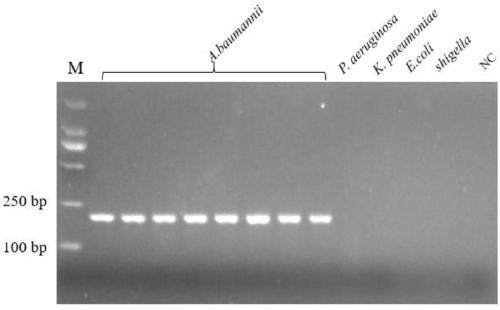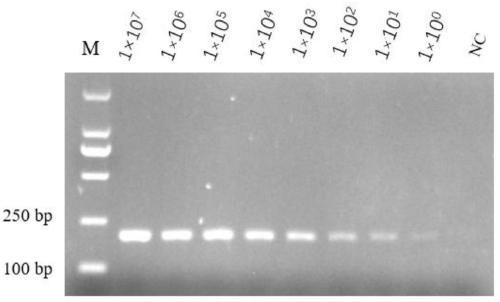Specific gene of Acinetobacter baumannii and primer and application thereof
A technology of Acinetobacter baumannii and specific genes, which is applied in the field of molecular biology to achieve the effects of good specificity, accurate detection and high sensitivity
- Summary
- Abstract
- Description
- Claims
- Application Information
AI Technical Summary
Problems solved by technology
Method used
Image
Examples
Embodiment 1
[0038] Example 1: Specific target gene screening and primer design
[0039] 1. Local BLAST analysis
[0040] Download the non-redundant nucleic acid database (about 60G) from NCBI to construct the target database. The complete genome sequence of Acinetobacter baumannii downloaded from NCBI (http: / / www.ncbi.nlm.nih.gov / genome / ) was used as retrieval data. Perform a local BLAST search to obtain the comparison results of each sequence fragment of the strain and the database. The search results were screened by self-compiled software to obtain potential specific sequences, and subsequent screening was carried out.
[0041] 2. Specific target gene screening
[0042] Using the online BLAST function in NCBI (http: / / www.ncbi.nlm.nih.gov / genome / ), two criteria were used to confirm its species specificity and species identification availability. One is to exclude Acinetobacter baumannii during BLAST, and the results show that there is no similar sequence or the similar sequence cove...
Embodiment 2
[0045] Embodiment 2: Collection and pretreatment of environmental samples
[0046] 1. Collection of environmental samples
[0047] (1) Moisten a sterile cotton swab with sterile physiological saline, wipe the surface of the sample to be tested (about 3cm-5cm), immerse it in a sterile centrifuge tube containing 1mL of enrichment medium, stir gently, discard the cotton swab, Bring the sterile centrifuge tubes back to the lab for the experiment. If it is a water sample, draw the water directly with a sterile tip or straw, and drop it into a sterile centrifuge tube filled with 1mL of enrichment medium for enrichment.
[0048] 2. Pre-enrichment culture of environmental samples
[0049] In order to improve the detection rate, pre-enrichment culture was carried out. The conditions were 4 hours in a shaking incubator at 37° C. with a rotation speed of 120 rpm.
[0050] 3. Bacterial culture
[0051] Take 100 μL of the pre-enriched culture solution and add it to a 5 mL glass test t...
Embodiment 3
[0052] Embodiment 3: the establishment of detection method
[0053] 1. Extraction of DNA
[0054] (1) Use the bacterial genomic DNA mini-extraction kit of Beijing Zhuangmeng International Biogene Technology Co., Ltd. for extraction and recovery, the steps are as follows:
[0055] 1) Take 2mL of overnight cultured bacterial solution, put it in a centrifuge, centrifuge at 12000rpm for 1.5min, and discard the supernatant.
[0056] 2) Next, add 500 μL of cell suspension to the centrifuge tube in the previous step, pipette and mix the solution, put it into a pre-heated water bath, and bathe in water at 37°C for 60 minutes. During the period upside down 3-4 times. Centrifuge at 12000rpm for 2min.
[0057] 3) After discarding the supernatant, slowly add 225 μL of buffer A to the top of the tube, and mix well by pipetting.
[0058] 4) Add 10 μL of RNaseA solution to the tube and shake for 15 seconds.
[0059] 5) After standing at room temperature for 5 minutes, add 10 μL proteina...
PUM
 Login to View More
Login to View More Abstract
Description
Claims
Application Information
 Login to View More
Login to View More - R&D
- Intellectual Property
- Life Sciences
- Materials
- Tech Scout
- Unparalleled Data Quality
- Higher Quality Content
- 60% Fewer Hallucinations
Browse by: Latest US Patents, China's latest patents, Technical Efficacy Thesaurus, Application Domain, Technology Topic, Popular Technical Reports.
© 2025 PatSnap. All rights reserved.Legal|Privacy policy|Modern Slavery Act Transparency Statement|Sitemap|About US| Contact US: help@patsnap.com



